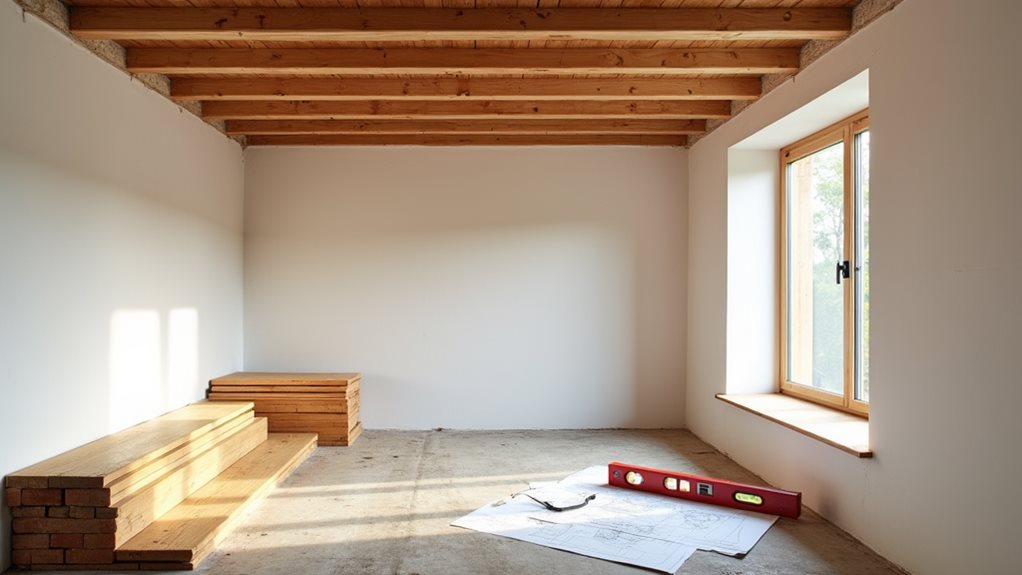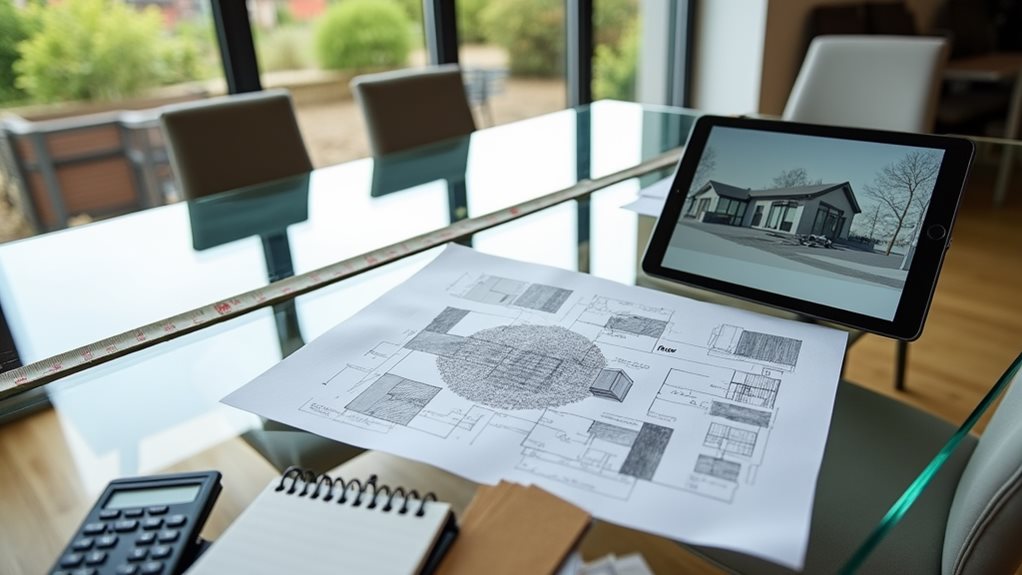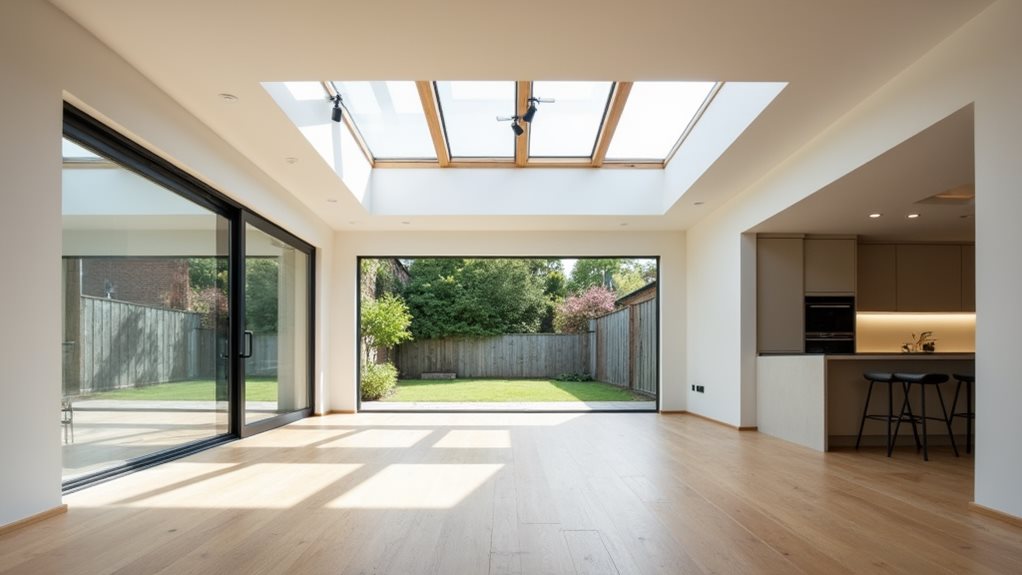Phone:
(701)814-6992
Physical address:
6296 Donnelly Plaza
Ratkeville, Bahamas.

Transform your home with expert tips for building a single-story extension, from planning permissions to perfect execution.
Building a single-story extension requires careful planning and attention to detail. You'll need to establish a realistic budget of £1,250-£4,000 per square meter, plus 30-35% for professional fees and permits. Start by checking permitted development rights, then focus on design elements that maximize natural light and space. Working with experienced architects and contractors while maintaining strict budget tracking will guarantee success. The journey to your dream extension involves essential steps that'll transform your vision into reality.

When planning a single-story extension, you'll need to carefully balance your aspirations with practical financial considerations. Understanding your extension value is essential, as you'll want to guarantee your investment aligns with your home's potential market increase. Additionally, consulting with local builders can provide insights into unique challenges specific to the North West.
Start by consulting local estate agents to determine the ceiling price in your area and calculate potential returns. Working with an experienced architect can help optimize your design, though they typically charge 5% to 12% for plans.
A thorough cost analysis will help you make informed decisions about design complexity and size. You're looking at £1,250 to £1,800 per square meter for budget-friendly builds, while premium work can reach £4,000 per square meter.
Remember to factor in an additional 30-35% for professional fees, permissions, and interior finishing. Keep your design simple with rectangular shapes and pitched roofs, as complex layouts will greatly impact your budget.
Understanding planning permissions might seem challenging, but it's vital to navigate this process before you begin your extension project.
Most single-story extensions fall under permitted development rights, which means you won't need full planning applications if your project meets specific criteria. However, you'll need to guarantee your extension complies with size limits and boundary considerations. The materials used must visually match the house to maintain architectural consistency.
Three important steps you'll need to follow:

The art of maximizing space and light stands at the heart of any successful single-story extension. You'll find that space optimization begins with choosing the right extension type – whether it's rear, side, or wraparound – to complement your home's existing layout.
When you're planning your design, consider how glass elements can transform your space: frameless structural glass roofs, skylights, and floor-to-ceiling windows will flood your extension with natural lighting while creating that coveted indoor-outdoor connection.
To make your extension feel seamlessly integrated, you'll want to focus on consistent finishes and materials.
Consider ultra-slim framed doors and windows that not only look contemporary but also maximize your views and light intake.
Selecting the perfect type of extension for your home requires careful consideration of both practical needs and architectural possibilities.
When exploring different extension types, you'll want to align your choice with your lifestyle while maximizing your property's potential.
Consider these key design considerations before making your decision:
You'll find that single-storey extensions offer remarkable versatility, whether you're looking to create an open-plan kitchen, a sunlit family room, or a seamless indoor-outdoor living space that transforms your home's functionality.

Mapping out your construction timeline won't just keep your extension project organized but will help you anticipate potential delays and budget fluctuations.
You'll need to coordinate with multiple contractors, ensuring each phase flows smoothly from foundation work through to final finishing touches.
Managing your contractors effectively means establishing clear communication channels, setting explicit deadlines, and maintaining detailed documentation of all work completed.
Successfully planning a single-story extension requires understanding the four major construction stages and their interconnected timelines.
As you map out your timeline considerations, you'll need to account for each phase's scheduling milestones and potential overlaps between stages.
Remember, you're joining a community of homeowners who've navigated this journey before.
Building your extension is like orchestrating a well-choreographed performance – each trade must enter at precisely the right moment to maintain flow and efficiency throughout the project.
With your build timeline established, the spotlight shifts to one of your most impactful decisions: managing construction contractors.
You'll want to start with thorough contractor evaluation, checking their certifications, insurance coverage, and past project experience. Verify their references and ascertain they're registered with professional bodies like the Federation of Master Builders.
Once you've selected your contractor, focus on creating a detailed contract that outlines the project timeline, payment milestones, and specific responsibilities.
You'll need to stay actively involved throughout the construction process, from site preparation through to the final interior work. Regular site inspections, quality control checks, and clear communication will help keep your extension project on track.
Building a single-story extension requires careful collaboration between architects and builders, who serve as the cornerstone of your project's success.
When discussing architectural styles and maintaining builder communication, you'll need to establish clear channels for feedback and decision-making throughout the process.
To guarantee your project runs smoothly, consider these essential steps:

When you're planning your single-story extension, you'll need to strike a careful balance between managing costs and maximizing value through smart investment choices.
Your budget strategy should include getting multiple contractor quotes, considering pre-designed plans to reduce architect fees, and carefully selecting materials that offer the best quality-to-cost ratio.
You can enhance your extension's long-term value by incorporating high-end features strategically, such as underfloor heating or custom cabinetry, while keeping the overall design simple and proportionate to your existing home.
Smart budgeting lies at the heart of any successful single-story extension project, where careful financial planning can make the difference between a dream renovation and a costly nightmare.
You'll want to focus on sustainable materials while maintaining strict budget tracking to guarantee your project stays on course.
Here are three essential strategies to help you manage your extension budget effectively:
Successfully maximizing your return on investment requires a strategic approach that balances cost-effective decisions with value-adding features in your single-story extension.
To optimize your return potential, focus on incorporating high-quality materials and energy-efficient elements that'll appeal to future buyers while managing construction costs effectively.
Your investment strategies should prioritize features that add lasting value, such as well-designed kitchens or thoughtfully planned living spaces.
You'll want to take into account current market trends and local property values when selecting materials and finishes.
By working with qualified professionals and maintaining strict budget controls, you can guarantee your extension delivers maximum value.
Remember that proper planning permissions and building regulations compliance aren't just legal requirements – they're essential safeguards for your investment's future worth.
Building your single-story extension isn't just about adding space—it's about enhancing your lifestyle, increasing your home's value, and creating a lasting investment. Whether you're expanding your kitchen, adding a sunroom, or creating a home office, you'll need careful planning, professional guidance, and attention to detail. Remember: successful extensions blend seamlessly with your existing structure while reflecting your unique vision and practical needs.